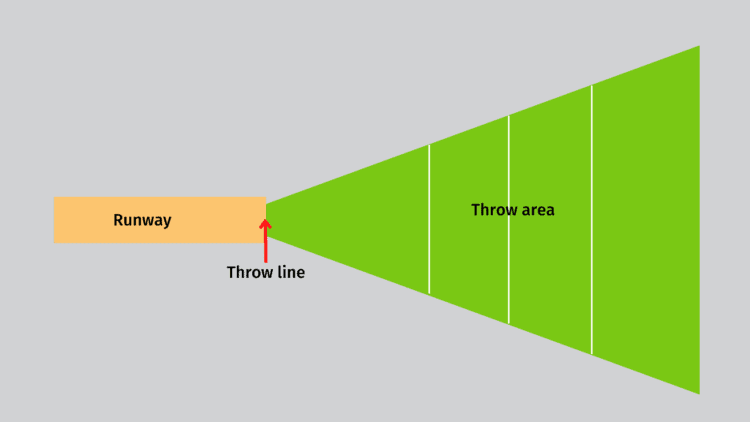
OBJECTIVE OF JAVELIN THROW: Throw a javelin as far as possible, starting from the throw line.
NUMBER OF PLAYERS: 3+ players
MATERIALS: Javelin, shoes with spikes (no more than 11 spikes), chalk
TYPE OF GAME: Sport
AUDIENCE: 10+
OVERVIEW OF JAVELIN THROW
Athletes compete in a throwing contest by launching a javelin with a metal tip as far as they can. It calls for a blend of power, strength, coordination, timing, and precision. Since 1908 for men and 1932 for women, this ancient game has been a standard part of the schedule for the modern Olympic Games.
SETUP

RUNWAY
The javelin runway is 4 meters (13 feet) wide and 36 meters (118 feet) long. The players will run with the javelin down this runway before reaching the throw line, from which they must stop and toss the javelin.
THROW AREA
The throw area is a triangular region of the field that starts from the runway and goes up to over 100 meters (330 feet), the field widens at a 29-degree angle. There are arced lines marking every 10 meters on the throwing area.
REQUIREMENTS OF EQUIPMENT
The length of the men’s javelin must be between 2.6 and 2.7 meters (8 feet 7 inches to 8 feet 10 inches), while the length of the women’s javelin must be between 2.2 and 2.3 meters (7 feet 3 inches to 7 feet 7 inches).
The minimum weight of a man’s javelin is 1.8 pounds, whereas a woman’s javelin weighs 1.3 pounds. Throwers wear shoes with spikes. A maximum of 11 spikes are allowed on the shoe, and they must be no longer than 12 mm (or .5 inches) and no wider than 4 mm (or .15 inches).
Throwers are only permitted to use chalk to improve their grip; they are not permitted to tape their hands unless injured.
GAMEPLAY

THROWING ORDER
Most javelin throw tournaments start with 10-20 players. Each player will initially get 3 tries to throw their javelin as far as possible. After each player has gone 3 times, the top 8 throwers move on to the next round. The top 8 players then get 3 more tries to throw the javelin as far as possible.
THROWING RULES
The athlete must hold the javelin with one hand on the cord grip in order to throw it correctly. Gloves are prohibited, and tape on the fingers is only acceptable to cover an open cut. Throwing the javelin requires an over-shoulder motion. The javelin must be in the air before the contestant may turn away from the throwing location.
SCORING
The tip of the javelin must strike the ground before any other part. The javelin must also be within the triangular boundary. Additionally, the javelin must leave a recognizable mark on the ground inside the throwing area’s boundaries. Referees gauge a throw’s distance from the part of the javelin that is closest to the throw line.
FOULS
A referee places a white flag for a fair throw or a red flag for a foul after each throw. There are various kinds of fouls. A red flag means that the shot does not count, and the player cannot retry the attempt.
- A thrower’s foot touches outside the throw line.
- The javelin lands outside of the boundary lines.
- The player steps outside of the runway line.
- The javelin is thrown underarm.
One of the most important rules is that throwers are not allowed to turn their backs to the field from the moment they are in throwing position until the javelin is released. The javelin must be released with just one hand and hurled fluidly up and over the arm.
END OF GAME
The playerwith the best throw out of all six tries wins the match. If the best throw is tied with another player, the player with the highest second-best throw wins.
- 30 GAMES TO PLAY OVER TEXT - April 22, 2024
- 20+ FREE PRINTABLE BABY SHOWER GAMES - April 16, 2024
- 20+ College Party Games for the Best Night Ever! - April 2, 2024